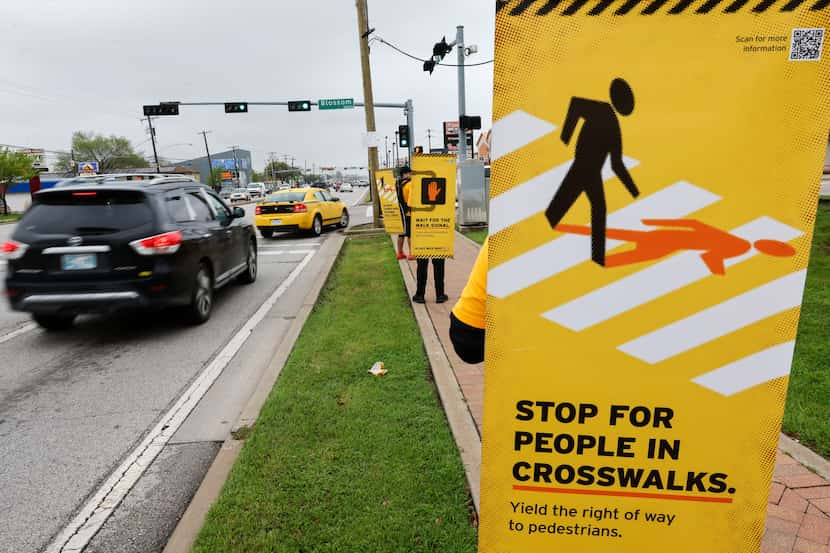Dallas faces a “major challenge” in improving traffic safety as the city seeks to eliminate collision-related deaths and cut severe injuries in half by 2030, the city’s transportation director told the Dallas City Council on Wednesday.
The city of Dallas is making progress on its Vision Zero plan to address traffic deaths, according to Dallas transportation director Gus Khankarli. But the city could face an uphill climb to meet the 2030 deadline, and council members have expressed frustration about the pace.
At Wednesday’s council briefing, Dallas Police Department Chief Eddie Garcia said the inability to enforce speeding laws boiled down to staffing resources. The department has 29 traffic enforcement officers who oversee the length and breadth of traffic issues in Dallas, he said.
Garcia said having speed radar cameras on red lights would help fill staffing gaps.
“We certainly are not going to be in a position anytime soon to be able to staff every intersection in the city,” Garcia said. There needs to be a “legislative push” to get the department up to speed with technology that can address driving behavior, he said.
Vision Zero initiative
Dallas is one of more than 45 cities, including Austin, Houston and San Antonio, to participate in the Vision Zero pledge initiative. But those cities have seen little progress toward eliminating fatalities despite investing years in the program.
“Other cities are also struggling with this process,” Khankarli said. “It’s a major challenge as cities try to implement the Vision Zero concept.”
Council members have previously expressed frustration with what they have seen as a slow rollout of the plan, which officials first committed to in 2019.
On Wednesday, council members wanted to figure out what the city could do to combat reckless driving. Should the city run a campaign? Should there be more education around traffic fatality statistics? What should the shock value of the messaging be?
“If you are not evoking some kind of emotion and usually more distress than happy emotion, then you’re not going to cut through,” council member Gay Donnell Willis said.
Council member Chad West lauded the data team for analyzing locations of the city’s worst crashes. “But I’m still frustrated in the fact that we as a city can’t do more,” he said.
The COVID-19 pandemic, engineering recruitment issues, extreme weather events and supply chain problems have slowed down the implementation process, Khankarli told the council. The transportation department has been operating at 65% to 70% engineering capacity.
The city’s transportation staff has also run up against consultant capacity and a “severe challenge” with a lack of bids from contractors to construct traffic signals, higher job costs and a backlog of previously contracted work, he said.
“It’s not like we’re not doing anything or not progressing things,” Khankarli said. “It’s just that the nature of the market is posing such a major challenge on the resources, or taxing the resources even, on the contractor side as we move forward.
Dallas roads among the deadliest
Dallas roads are among the deadliest nationwide for pedestrians, according to the National Highway Traffic Safety Administration, prompting some residents to advocate for pedestrian zones downtown.
More than half of all Dallas crashes last year happened on city-operated roadways. While motorists accounted for the greatest number of deaths between 2019 and 2023, pedestrians accounted for 35% of fatalities.
About 7% of Dallas streets account for 57% of severe crashes; they are part of a “high injury network.” Street segments that are part of the network are being prioritized for corridor studies, with a goal of evaluating an average of five high-injury corridors per year. Each study takes between 10 and 14 months, with an average cost of $200,000 each.
Six corridor studies — including at Ferguson Road, Gaston Avenue, Lake June Road, Mountain Creek and West Clarendon Drive — are in the draft report phase with consultants, while 14 are in the project kickoff phase. The studies will allow transportation staff to identify challenges and come up with a plan for each road segment.
Bond funds
The Vision Zero strategy encourages design that makes roads easy to navigate for all users. The strategy ties in with other city initiatives like Complete Streets, which is aimed at designing streets for multiple transportation modes.
Bond fund allocations for 2024 include $53 million to the transportation department, with $8 million base funds allocated to Vision Zero and another $4.4 million toward the initiative through district-specific projects.
The bond also includes over $143 million for Complete Streets and partnership projects such as work on Martin Luther King Jr. Boulevard, Harry Hines to downtown and Frankford Road/Dallas North Tollway.
Though crashes often have multiple causes, most are speed-related, according to data from the Texas Department of Transportation. Speeding, red-light running and a lack of pedestrian safety have all been identified by residents of Ferguson Road in East Dallas, and neighbors on Mockingbird Lane want a traffic light installed after a fatal crash at a nearby intersection.
Not wearing a seat belt has also been linked to more severe crashes, with people of color disproportionately represented in fatalities where seatbelts are not worn.
Dallas’s Vision Zero plan coincides with the Texas Department of Transportation’s Highway Safety Improvement Program, also aimed at reducing fatalities and serious injuries.
That statewide program has included new, reconstructed and replacement signals on state roadways. Crashes have increased about 8% at intersections where a red light camera was once operating since deactivation of the agency’s red light camera program in June 2019, including a 50% increase in fatal crashes, Khankarli said.
Among those, the intersection at Frankford Road and the Dallas North Tollway in North Dallas had “the single largest increase of all intersections in the city of Dallas,” increasing from 95 to 171 for a net increase of 76 crashes.
Other improvements completed or underway include a new crosswalk, speed cushions and flashing beacon at Adamson High School, and two new school zones each at Parish Episcopal School and Geneva Heights Elementary School.



/cloudfront-us-east-1.images.arcpublishing.com/dmn/VC37PWTODRBYFOGXCHJGSTMXCU.jpg)
/cloudfront-us-east-1.images.arcpublishing.com/dmn/EZCUDS5AUPUUFV3U4IXFNBPODA.jpg)
/cloudfront-us-east-1.images.arcpublishing.com/dmn/C5T3J6VAXZHPNMZ5UYRXYWI6MQ.jpg)
/cloudfront-us-east-1.images.arcpublishing.com/dmn/LODBJNMDFGLX7L6W6NESBKJ2NM.jpg)
/cloudfront-us-east-1.images.arcpublishing.com/dmn/YCCK6D63IM3ZX4LNXMDZBLMYVQ.jpg)